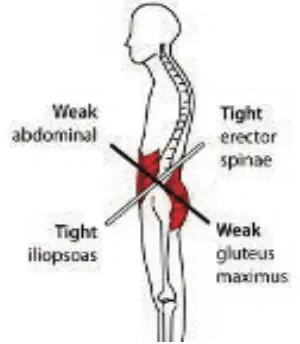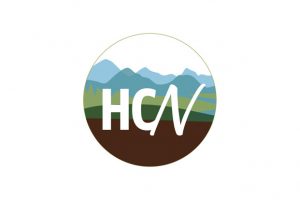LOWER CROSSED SYNDROME
 This term, and posture description, refers to muscle imbalances in the lower back and hip region. We commonly see tight lower back extensors matched with tight hip flexors and weak abdominal muscles matched with weak gluteal muscles. This criss-cross pattern of muscle imbalance in our body creates joint dysfunctions, poor movement patterns and often pain in the lower back, pelvis, hips or knees. Our bodies are very accommodating and take the path of least resistance. When one muscle group is tight, the opposing muscle groups are inhibited in function so that they “weaken” to accommodate the “tightness” on the other side of that joint. This is a process called “reciprocal inhibition”.
This term, and posture description, refers to muscle imbalances in the lower back and hip region. We commonly see tight lower back extensors matched with tight hip flexors and weak abdominal muscles matched with weak gluteal muscles. This criss-cross pattern of muscle imbalance in our body creates joint dysfunctions, poor movement patterns and often pain in the lower back, pelvis, hips or knees. Our bodies are very accommodating and take the path of least resistance. When one muscle group is tight, the opposing muscle groups are inhibited in function so that they “weaken” to accommodate the “tightness” on the other side of that joint. This is a process called “reciprocal inhibition”.
What causes this imbalance? Posture! We hear it all the time and there are some activities we just can’t avoid. Driving to work and sitting at our computers are the most common, but we often carry these postural habits around with us elsewhere. Improper exercise technique, repetitive movements, standing postures, and physical inactivity. The development of these muscle imbalances occurs over time. This sets us up for a cycle of habitual movement patterns and using other muscles to compensate. Eventually this results in pain somewhere in our body as certain structures ‘start complaining’ from overuse and strain.
We commonly see weak gluteal and abdominal muscles. When these muscle groups aren’t engaging well, the hamstrings and lower back muscles are recruited to assist in activities such as walking, running and squatting. This leads to overuse and tightness of the hamstrings and lower back. One of our hip flexors, the iliopsoas muscle, originates on the front aspect of the lumbar spine and travels down to the front of the hip. Due to these attachment sites, this muscle is shortened when we sit and when tight, pulls on our lumbar spine in standing. Even though this muscle attaches on the front of our spine, the ache and tightness often manifest as lower back pain.
How can we correct this? Body awareness and posture correction are two important aspects you can focus on through your day. Identifying these imbalances, learning how to stretch properly and strengthening weak muscles are what will take a little work and practice! While there isn’t one approach that works for everyone, there are a few tips that may help you identify some imbalances in your body.
- Standing posture – take a look at yourself in a mirror from the front and from the side. Do you let your belly hang forward and have excessive curvature at your lower back? Do you have a flat buttock? Do you round at the shoulders and have too little curvature at your lower back? Try standing up against a wall with your feet a few inches from the wall. Stand tall, shoulders back, head against the wall. You should have some curvature at your lower back and behind the neck. How does this position feel?
- Lay on your back with your knees bent and feel the difference between an anterior pelvic tilt (arching your lower back) and a posterior pelvic tilt (flattening your back). Can you find a neutral zone? Can you keep your neck flat with a slight chin tuck position?
- Glute squeezes. Can you squeeze your butt muscles? Can you squeeze the left and right independently and the same amount? Think of engaging your glutes while you are walking, running, and cross country skiing.
- Lunge stretch. Place one foot on a secure chair or stair, stand tall through the torso, abdominals drawn in and slowly lunge forward, bending your front knee and keeping your standing leg straight. You should feel a stretch through the front of your standing leg. This can be progressed to a lunge position with one knee on the floor (wedding proposal position).
Other exercises such as squats, plank, bridging, and the child’s pose stretch can also be beneficial for core strengthening. As these exercises have multi-joint involvement and require proper technique, it is best to seek professional advice, be properly assessed and receive an individual exercise program. Our therapists at Bragg Creek Physiotherapy are well versed in these common but troublesome muscle imbalances and we would love to see you before more sinister injuries crop up!
Come see us for a professional biomechanical assessment so we can find and treat any relevant muscle imbalances, pain or movement dysfunctions you may have.
Jennifer Gordon (BSc.PT, BA Kin, AFCI)
Physiotherapist – Bragg Creek Physiotherapy
www.braggcreekphysio.com

























